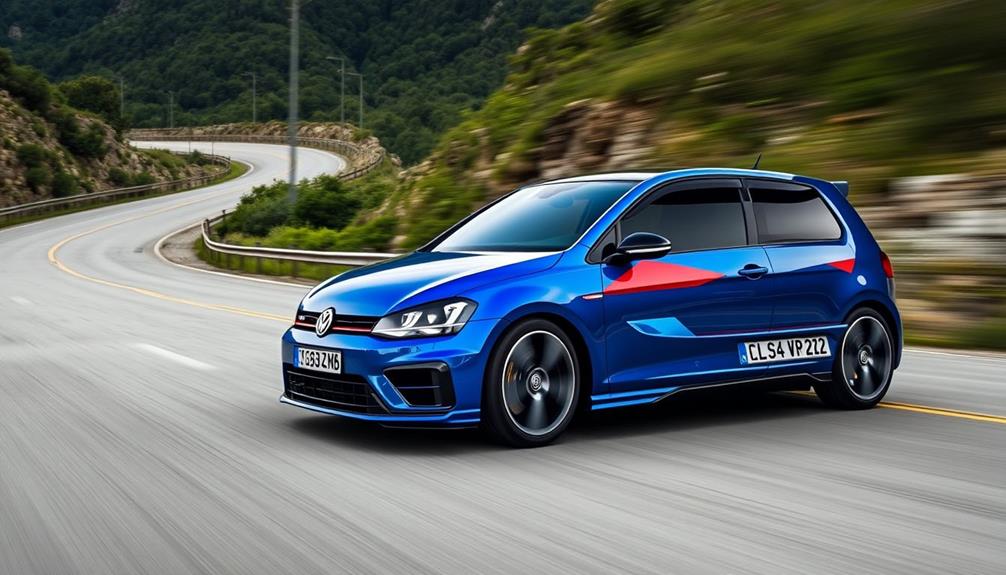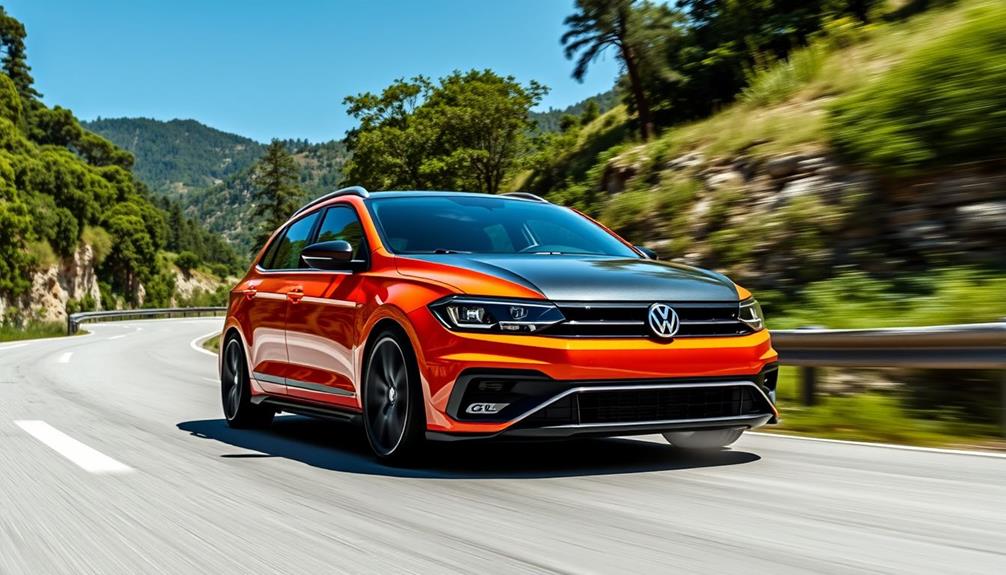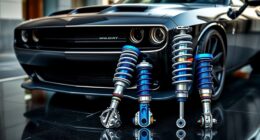To maximize efficiency in your 2025 Golf R, focus on ECU tuning by choosing low-torque maps, optimizing octane-specific settings, and adjusting partial-throttle calibrations for leaner fuel mixtures. Switch to Eco or Drive modes for better throttle response and shift points. Consider upgrading intake and exhaust systems to improve airflow, and fine-tune the transmission for smoother, quicker shifts. Keep exploring these options to uncover even more ways to boost your ride’s fuel economy.
Key Takeaways
- Implement Stage 1 low-torque ECU maps and octane-specific tuning to optimize fuel combustion and reduce hardware stress.
- Select Eco or customized driving modes to adjust throttle response and shift points for maximum fuel savings.
- Fine-tune partial-throttle calibrations for leaner air-fuel ratios during cruising to lower fuel consumption.
- Upgrade intake and exhaust systems to improve engine efficiency and promote cleaner, more economical burns.
- Regularly monitor transmission performance and optimize shift points to minimize energy loss and enhance overall fuel economy.
Optimizing ECU Settings for Fuel Economy
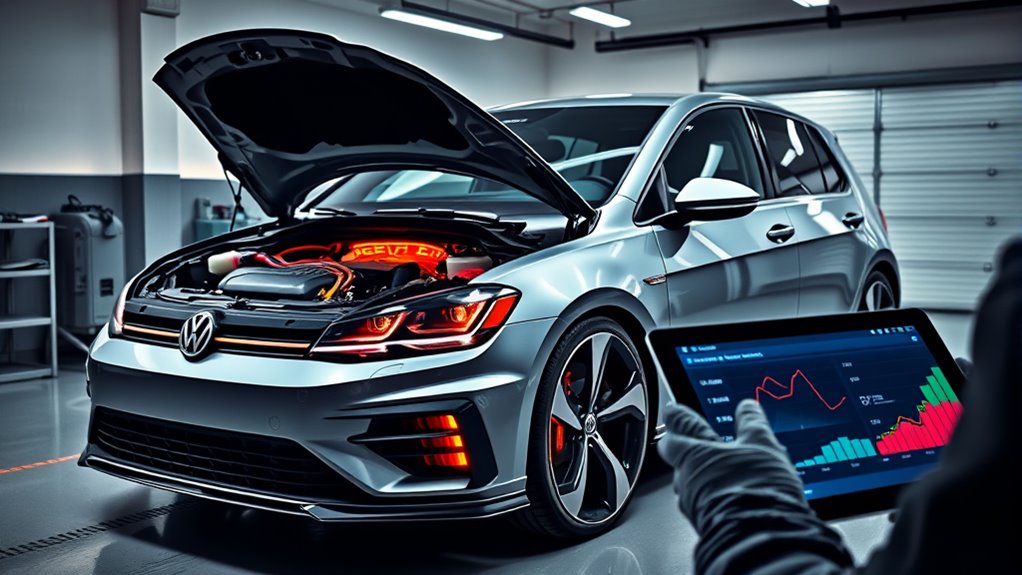
To maximize fuel economy through ECU tuning, you should focus on implementing strategies that optimize combustion efficiency without compromising reliability. Start with Stage 1 low-torque maps that reduce stress on your stock hardware while boosting efficiency, helping you reach up to 35 MPG on highways. Use octane-specific tuning for 91, 93, or E85 fuels to fine-tune ignition timing and fuel delivery, ensuring cleaner burns and less waste. Adjust partial-throttle calibrations to favor leaner air-fuel ratios during cruising, which minimizes fuel consumption. Torque limiters also help by preventing unnecessary power delivery during non-performance driving, saving fuel. Additionally, ensuring your transmission compatibility is aligned with these tunes helps avoid transmission restrictions, maintaining smooth operation and maximum efficiency gains. Furthermore, staying informed about potential turbo revisions and monitoring for early failure signs can help maintain optimal performance and fuel economy over time turbo reliability. Regularly reviewing your vehicle’s risk management strategies can further safeguard against unforeseen issues and ensure sustained efficiency improvements.
Leveraging Drive Mode Adjustments for Efficiency
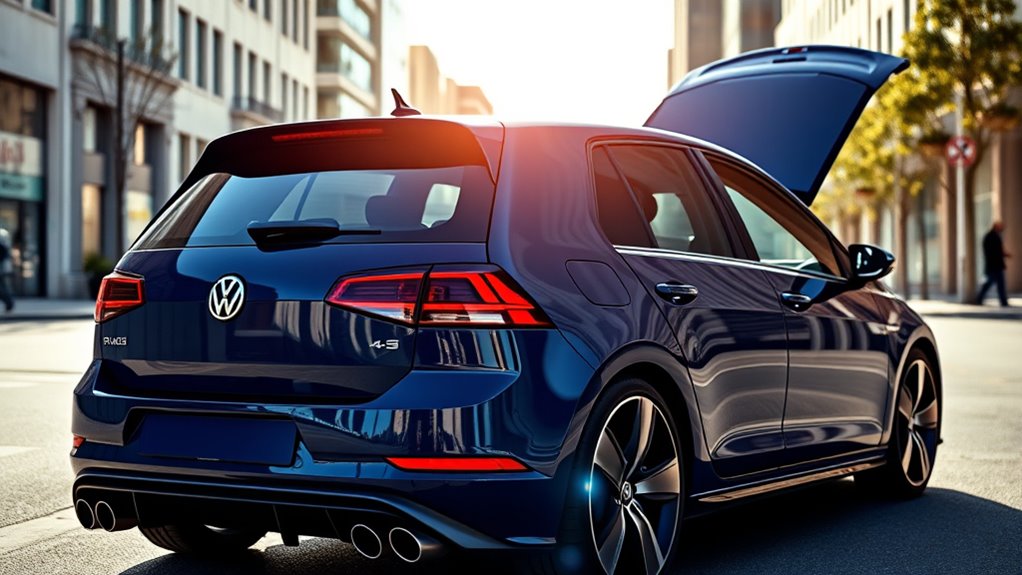
Adjusting your drive mode settings is one of the most straightforward ways to enhance fuel efficiency in your 2025 Volkswagen Golf R. Selecting Eco mode optimizes the engine for fuel savings, making it ideal for highway driving. The Eco mode adjusts throttle response and transmission shift points to prioritize fuel economy. If you prefer a customized setup, the Individual mode lets you tailor settings to maximize efficiency based on your driving style. Comfort mode offers a smooth ride suitable for city driving, though it may not be as fuel-efficient as Eco mode. With seven available drive modes, including Eco, Comfort, and others, you can choose the most efficient option for current conditions. Monitoring your driving habits and maintaining gentle acceleration, steady speeds, and switching modes based on road conditions further boosts your vehicle’s fuel economy. Additionally, understanding vehicle performance can help you optimize efficiency and get the most out of every gallon. Leveraging these modes helps you get the most out of every gallon.
Enhancing Launch and Acceleration Strategies
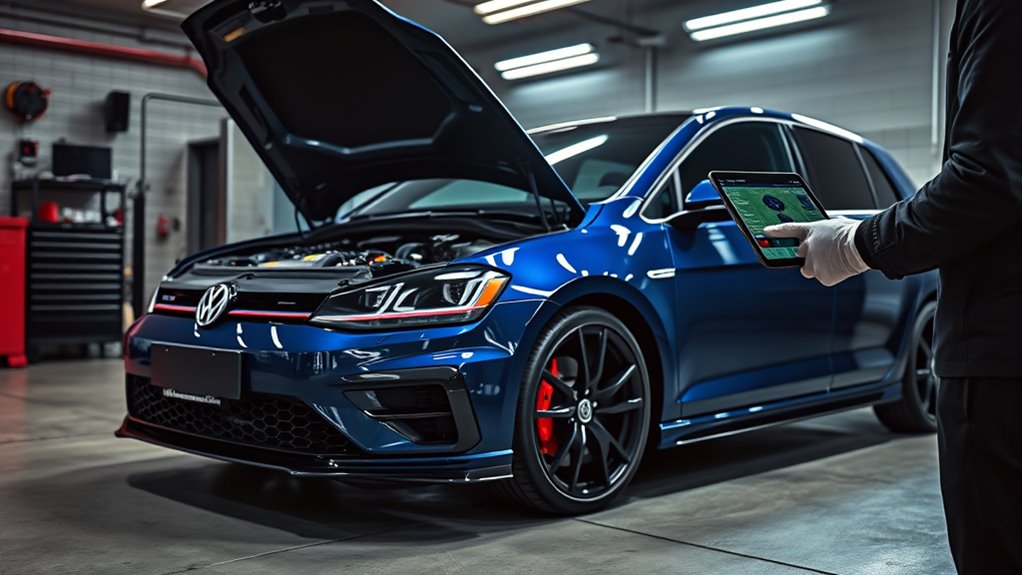
Maximizing your launch and acceleration performance in the 2025 Volkswagen Golf R involves more than just pressing the accelerator. Start by optimizing the engine management systems to improve power delivery, ensuring smoother, more responsive launches. The updated turbocharged 2.0-liter inline-four engine now produces 328 horsepower, offering increased performance capabilities. Upgrading the cooling system helps maintain peak engine performance during repeated accelerations, while improved air intake systems boost combustion efficiency. A lightweight, high-flow exhaust reduces backpressure and increases power output. Reducing vehicle weight with lighter body panels and components improves your power-to-weight ratio, enhancing acceleration. Upgrading to lightweight wheels and high-grip tires maximizes traction, especially during aggressive launches. Additionally, tuning suspension and electronic differential systems helps manage power distribution and grip. Incorporating advanced performance tuning software can further refine these adjustments for optimal results. This software allows for precise calibration of engine parameters, ensuring consistent and peak performance. These strategies, combined, guarantee you get maximum performance from every launch.
Upgrading Transmission and Shift Performance
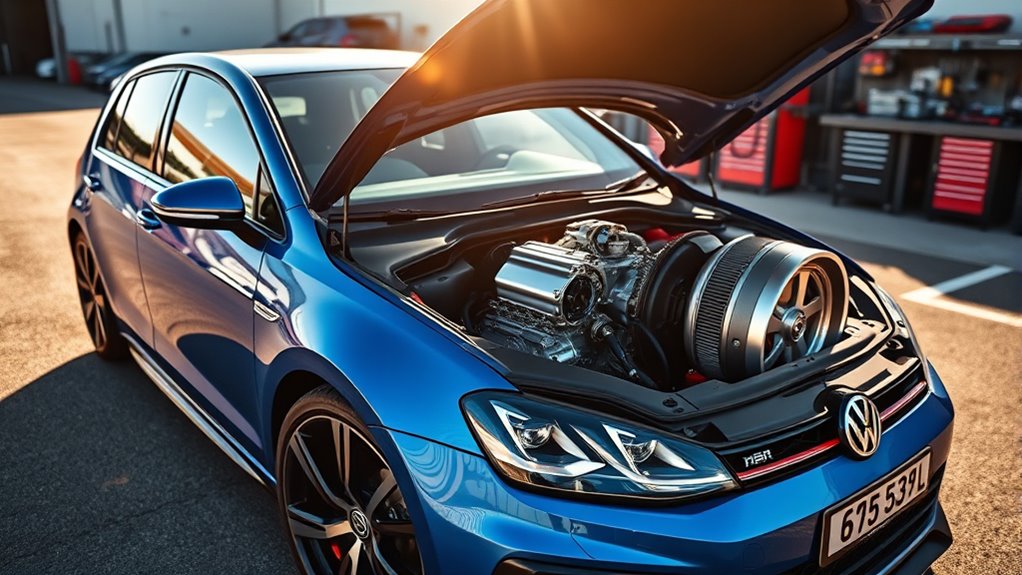
Upgrading the transmission and shift performance of your 2025 Volkswagen Golf R can considerably boost overall driving dynamics and responsiveness. Improving shift speed through TCU tuning or installing a short shifter enhances precision and reduces shift times. Shift speed is a key metric for improving driving skills and performance. For manual transmissions, lightweight clutches and flywheels can make shifts quicker and smoother. If you have a DSG, modifying clutch pressures and shift points can result in faster, more solid shifts. Upgrading transmission fluid with high-performance options improves shift smoothness and durability. Internal components like bearings and seals also contribute to efficiency and longevity. Regular monitoring of transmission performance and integrating ECU adjustments optimize shift points and torque management, ensuring seamless operation. These upgrades directly enhance your driving experience by making shifts more responsive and confident. Additionally, considering color accuracy in your vehicle’s display systems can improve visibility and driver alertness during performance driving.
Practical Upgrades and Compatibility Considerations
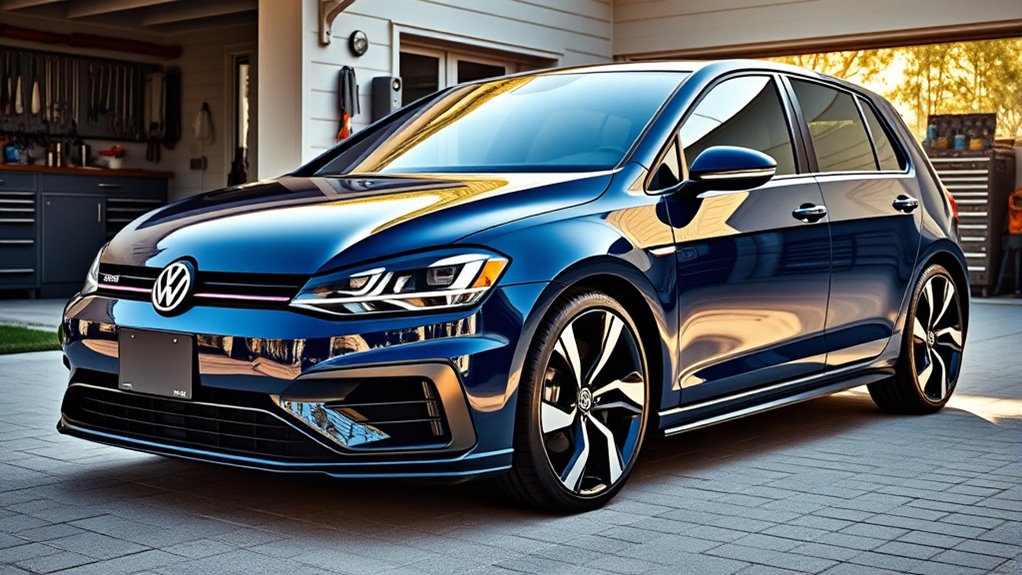
Enhancing your 2025 Volkswagen Golf R with practical upgrades requires careful consideration of compatibility to guarantee seamless performance gains. The engine already benefits from a 328-horsepower boost via an ECU reflash, a simple way to improve power. The turbocharged four-cylinder engine is built to handle additional tuning modifications. You can further tune the ECU for better turbo spool or fuel optimization, but be aware it might void your warranty. Upgrading the air intake with high-performance filters, or replacing the exhaust system to reduce backpressure, can also boost horsepower and sound. Improved intercoolers help manage engine temperatures during extended driving. Since the Golf R uses a 2.0-liter turbocharged engine compatible with aftermarket ECU tuning, ensure any modifications align with warranty and legal regulations. Community support and aftermarket options make these upgrades feasible without sacrificing reliability, especially given the proven durability of modern turbocharged engines. Additionally, researching hackathons related to automotive technology can provide innovative ideas and solutions for custom modifications and performance tuning.
Frequently Asked Questions
How Does ECU Tuning Affect the Long-Term Reliability of the Golf R?
You might wonder how ECU tuning impacts your Golf R’s long-term reliability. Proper tuning, especially from reputable providers, generally doesn’t harm your engine if maintained well.
It can even enhance performance without risking damage when done correctly. However, pushing your car beyond safe limits or neglecting regular maintenance could increase wear and potential failures over time.
Always monitor engine health and stay within recommended tuning parameters to keep your Golf R reliable.
Can Fuel Economy Improvements Compromise the Vehicle’S Overall Performance?
Improving fuel economy can sometimes impact your vehicle’s overall performance if not done carefully. You might notice reduced power or responsiveness, especially if power is sacrificed for efficiency.
However, with proper tuning—like adjusting engine calibration or driving modes—you can balance better fuel economy without substantially compromising performance. It’s all about fine-tuning the right settings to maintain a good mix of efficiency and driving enjoyment.
Are There Any Legal or Warranty Considerations When Tuning for Efficiency?
Think of tuning as steering a tightrope—you want to improve efficiency without losing balance.
Legally, you must guarantee your modifications meet emissions standards, like CARB approval, and pass visual inspections.
Warranties can be affected, potentially voiding coverage if issues arise.
Always disclose modifications when trading in, and stay aware of state laws.
Careful tuning keeps your vehicle both legal and covered, like a safety net beneath your performance leap.
How Does Tuning Impact the Vehicle’S Emissions Compliance?
Tuning affects your vehicle’s emissions compliance by potentially altering emissions systems like catalytic converters and particulate filters.
If you don’t tune properly, your car might fail emissions tests or trigger OBD codes, risking fines and failed inspections.
However, with the right software adjustments, hardware upgrades like high-flow catalytic converters, and maintaining emissions hardware, you can keep your vehicle compliant while enhancing performance.
Proper tuning guarantees you pass inspections without compromising environmental standards.
What Are the Best Practices for Maintaining Tuned Setups for Durability?
Your tuned setup is the heart of your vehicle’s performance, so treat it like gold. Regularly inspect and replace fluids, like oil, DSG fluid, and Haldex oil, to keep everything running smoothly. Stick to scheduled maintenance, monitor tire pressure, and keep software updated.
Drive moderately, allow cool-down periods, and promptly address warning signs. These practices prevent damage, making your car’s durability as unstoppable as a freight train.
Conclusion
Balancing performance with efficiency might seem like a paradox, but with careful tuning, you can achieve both. As you optimize your Golf R, remember that pushing for maximum fuel economy doesn’t mean sacrificing driving enjoyment. Instead, it’s about finding harmony—where precision adjustments meet spirited driving. Embrace the challenge of blending sustainability with thrill, turning your car into a finely tuned machine that’s as efficient as it is exhilarating.



